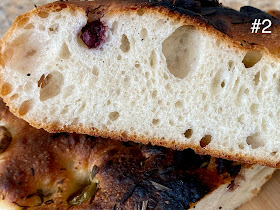Recently, my wife gave me an indoor-electric pizza oven, Breville Pizzaiolo as a birthday gift. I am making pizza several times using different flours, dough recipes and temperatures. Generally, I am quite impressed with the quality of pizza that can be made in this oven but I am still making pizzas to find the best combination for me. Once I have enough information, that will be the subject of a separate post. This post is just to note a few things I can do to improve the focaccia. The focaccia was great albeit one side of the top was a little too high done (#1). The result of using the top heating unit is a bit uneven for heating.
I used the carbon iron pan that came with the oven for baking the focaccia. I pre-seasoned the pan as per the instructions and it worked great. With a 30 minutes secondary rise, the bread has nice texture and flavors (#2). We really like the crusty surface and nice soft interior.
The recipe is just for my notes so that I can improve it next time.
Ingredients:
3 and 1/2 cup bread flour
2 tsp Kosher salt
2 tbs olive oil
2 tsp instant yeast
1 cup and a bit more lukewarm water
Olives, black and green, sliced
Fresh rosemary, leaves removed and roughly chopped
4 or more tbs olive oil
Directions:
Add the flour, salt and yeast to a food processor fitted with a kneading blade. Mix briefly and pour in the olive oil in a thin stream. While the blade is turning in low-speed, add the water in a thin stream. Look carefully until a dough ball forms above the blade (the dough ball is slightly sticky). Let is stand for 5 minutes for even hydration. Turn the processor on low speed for 1-2 minutes. Turn the dough ball out on well floured board and knead for 3-5 minutes making a smooth elastic dough. Shape the dough into a smooth round and place it in lightly oiled bowl, turning to coat. Let it rise for about 1 hour (I use a proofing box at 87F).
Deflate the dough and fold several times on well floured kneading board making a disk of dough. Cover with plastic wrap and let it rest for 10 minutes (so that the gluten relaxes and it becomes easier to stretch). Meanwhile lightly oil the carbon iron pan. Add the disk of dough in the pan and using your finger tips spread the dough to fill the pan. Add the rosemary to the olive oil and spread over the dough and scatter the olive slices. Using your finger tips, press and embed the olive (picture #3). Cover and let it rise for 30 minutes (or skip this and immediately proceed to baking*).
*I like the fluffy texture and usually let it rise second time but baking in the pizza oven, it may better without the second rising since the top heating element is very close to the surface.
Using the pan pizza setting (475F for 18 minutes) and the top heat in the middle (I may reduce the top heat to prevent the surface scorching too much, see picture #1).
Remove the bread from the pan using spatula and let it cool on the cooling rack.
We really like this version of focaccia bread. Compared to my usual focaccia, it has nice crust and the texture is much better. With a good flavorful olive oil with salt and a glass of good cab, we made the dinner from this bread.














